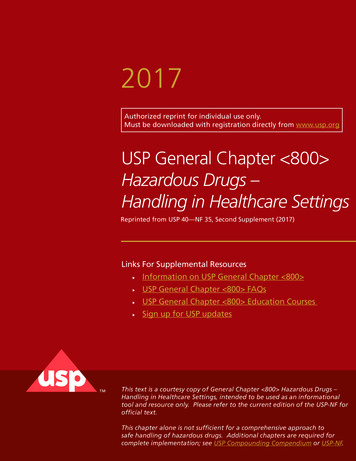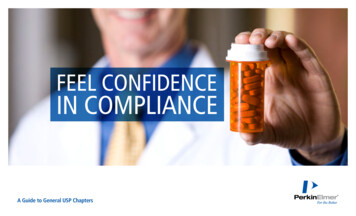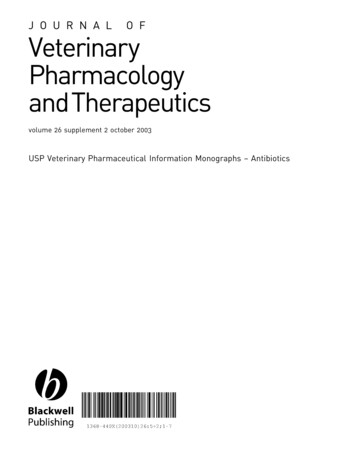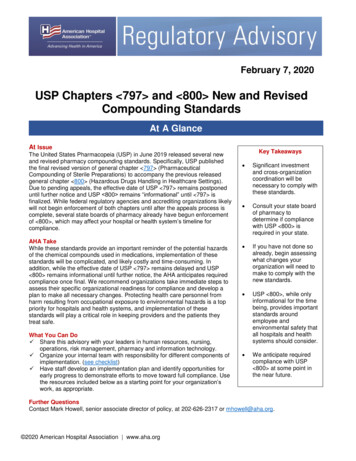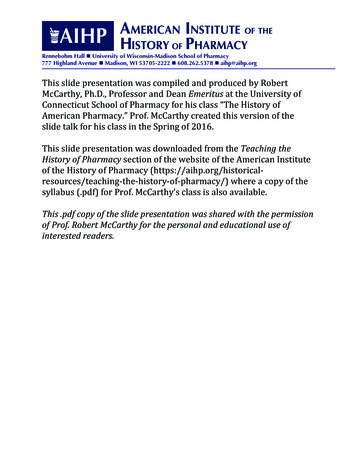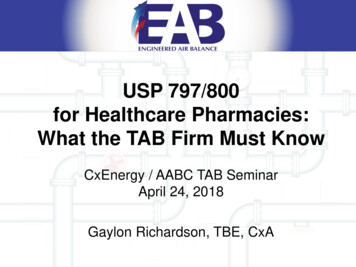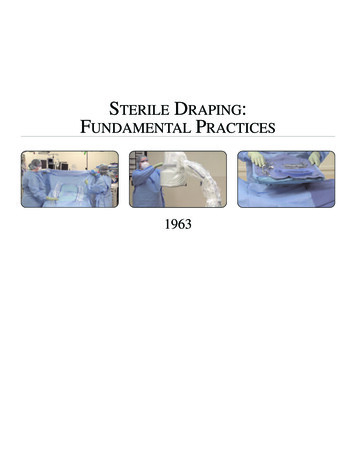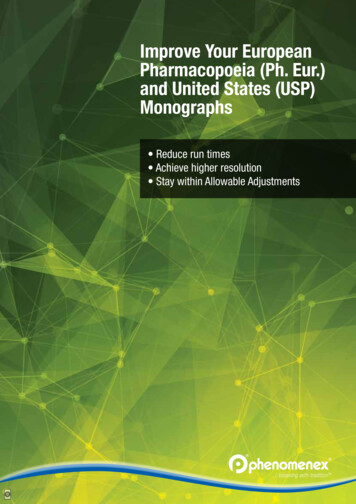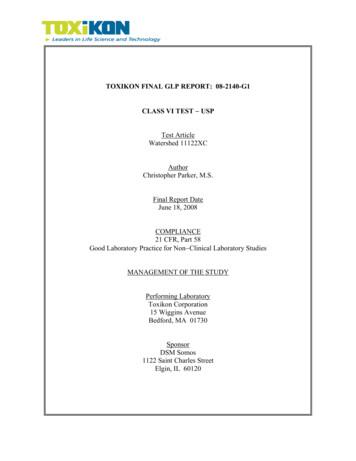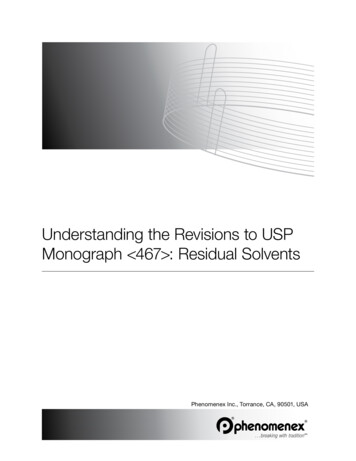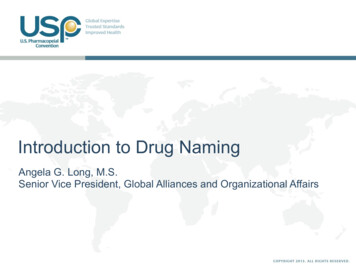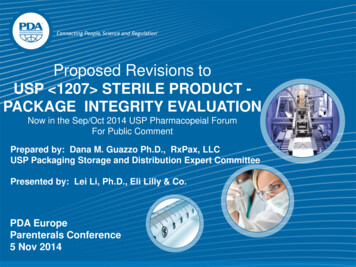
Transcription
Proposed Revisions toUSP 1207 STERILE PRODUCT PACKAGE INTEGRITY EVALUATIONPDA: A GlobalAssociationNow in the Sep/Oct 2014 USP Pharmacopeial ForumFor Public CommentPrepared by: Dana M. Guazzo Ph.D., RxPax, LLCUSP Packaging Storage and Distribution Expert CommitteePresented by: Lei Li, Ph.D., Eli Lilly & Co.PDA EuropeParenterals Conference5 Nov 2014
Presentation Outline Introduction Revision Rationale Revision Content Revision Timeline2
USP 1207 Proposed Revision (PR)The USP 1207 proposed revision (PR) can be found in:USP-NF Pharmacopeial Forum Sep/Oct 2014 Stimuli article 1207 1207.1 Package Integrity and test method selection 1207.2 Package integrity leak test technologies 1207.3 Package seal quality test methodsThe initial text was prepared by an Expert Panel, Commissioned by theUSP Packaging, Storage and Distribution Expert Committee and theUSP Microbiology Expert Committee3
USP 1207 PR Expert PanelExpert Panel Members James P. Agalloco, MSAgallaco & Associates James E. Akers, PhDAkers Kennedy and Associates Peter Buus, BScNovo Nordisk Shu-Chen Y. Chen, PhDAmgen Ronald G. Forster, PhDAmgen Dana M. Guazzo, PhDRxPax, LLC and USP Panel leader Desmond Hunt, PhDUSP Liaison Lee E. Kirsch, PhDUniversity of Iowa Ronald L. Mueller, PhDWest Pharmaceutical Services Donald C. Singer, MSGlaxoSmithKline Bio Marla K. Stevens-Riley, PhDFDA CDER David Walker, PhDMerck & Co.4
USP 1207 Revision RationaleThe world of packaging and leak testingis rapidly evolving, and greater guidanceis needed RESEARCH AND EXPERIENCE All leak test methods have pros/cons. No one method works for all applications. Probabilistic methods (e.g., microbial ingress and dyetests) are no longer preferred by leak testing experts.continued5
USP 1207 Revision Rationale TECHNOLOGICAL ADVANCES Product-packages are more complex Better leak testing instrumentation is nowcommonly available New methods are being developedcontinued6
USP 1207 Revision Rationale REGULATORY DEMANDS More testing throughout the product life cycle isexpected Well-validated, adequately sensitive physical leaktest methods (without microbial ingresscomparison) are permitted and preferred7
USP 1207 PR Stimuli Article Provides historical context to package integrityconcerns and testing approaches Summarizes key research findings, including Traditional, probabilistic test methodsdye/microbial ingress, bubble emission With comparisons to less traditional, deterministictest methodspressure/vacuum decay, tracer gas detection Provides reader with greater perspective andinsight when reading 1207 8
USP PR 1207 Introduction - Scope Sterile pharmaceutical dosage form packagesPrimary container closure systemsPackages of nonporous, rigid or flexible, materialsOTHER applications include, but are not limited to Porous flexible packages Critical secondary packages Sterile API, Intermediates, final bulk volume packages Drug/device combination packagesOUTSIDE the scope, but chapter concepts still apply Sterile medical device packages (nonporous only) Sterile diagnostic product packages9
USP PR 1207 Definitions “Package integrity” “container closure integrity”(CCI)“ the absence of package leakage greater than theproduct package maximum allowable leakage limit.” “Integral package” Prevents microbial ingress (ensures sterility) Maintains product CQA within P-C label claim specsooLimits loss of product contentsPrevents entry by debris or detrimental gases10
USP PR 1207 Definitions “Leak Tests (CCIT)” Loss of product contents Loss of critical headspaces gases Entry of non-viable particulates, liquids, reactive gases, microorganisms“Seal Quality Tests (SQT)” Leak tests detect the presence of (and in some cases the size orlocation of) package defect(s)Such defects are capable of permittingSQT characterize and monitor seal quality and consistencyPermeation tests are NOT included in 1207 11
USP PR 1207 Chapter conceptsRegarding current published standard tests (e.g., ISO/ASTM) Reader is directed to “existing methods andtechnologies supported by peer-reviewed publicationsand internationally recognized standards, based onsound scientific package testing principles.” The USP “encourages the development andimplementation of novel, innovative test methods.” Any chosen CCIT or SQT (even standard methods)require optimization and validation.12
USP 1207.1 Package integrity and test method selectionProduct life cycle testing3 Phases1.Product package development and validation2.Routine manufacturing3.Marketed product stability13
USP 1207.1 Package integrity and test method selectionPhase 1. Product package development and validationFactors that influence test method selection Product package profile End useStability requirementsMethod of manufactureAnticipated storage, shipment, distribution environment Package mat’ls, sources, dimensional tolerances Package processing steps and max. limits Package filling, assembly, terminal sterilization Package robustness for storage, shipping, distribution14
USP 1207.1 Package integrity and test method selectionPhase 2. Routine manufacturing testingImportant concepts Procedures & controls can minimize, not eliminate, CCI failurerisk“The goal is to prevent, or identify and remove those failures ofgreatest concern, precluding shipment of non-integral CC that riskproduct contamination or loss.” CCI to be verified post major changes in package design, materials,or manufacturing Nondestructive tests preferred in some cases15
USP 1207.1 Package integrity and test method selectionPhase 3. Marketed product stability testingImportant concepts CCIT (not sterility tests) recommended to ensure integrityover long-term storage CCIT cannot replace initial sterility test CCIT needed to verify absence of package damage ordeformation that could result in loss of product or sterility Indirect testing for CCIT may be acceptablee.g., headspace content verification16
USP 1207.1 Package integrity and test method selectionClosure Seal Type and MechanicsCites role of each in package integrity assurance Physically mated closure systemsVial stopper, Syringe plunger Physicochemically bonded closure systems Vent filtration closure systems Glass or plastic ampoulesPorous lidding on a trayMulti-dose product microbial blockage closure systems Ophthalmic product packages with product blockage mechanics17
USP 1207.1 Package integrity and test method selection10 Leak test selection criteria1.Package contentsGaseous orVacuum orLiquidProteinaceousororNo headspaceDry productSmall moleculesElectrically conductive or Nonconductive18
USP 1207.1 Package integrity and test method selection10 Leak test selection criteria2.Package design and materials of constructionFlexibleorNonporousElectrically conductiveRigidororPorousNonconductiveContiguous containers or Multiple seal types and locations19
USP 1207.1 Package integrity and test method selection10 Leak test selection criteriaProduct package maximum allowable leakage3. “Most package types demonstrate at least minisculegaseous leakage plus permeation even whenoptimally designed and assembled. with the exceptionof [well-sealed] glass ampoules ” “ the maximum allowable leakage into and out ofintact packages should be so minimal that there isno impact on product safety, and no consequentialimpact on the product’s physicochemical stability.”20
USP 1207.1 Package integrity and test method selection10 Leak test selection criteria3.Product package maximum allowable leakageCategories1. Liquid leakage must be blocked 2.Headspace gas or pressure must be preserved 3.preserving product contents and product sterilityensuring product stability and sterilityMicrobial ingress must be prevented, while stillpermitting gas/liquid flow ensuring product sterility (e.g, Tyvek barrier material)21
USP 1207.1 Package integrity and test method selection10 Leak test selection criteria4.Deterministic vs. Probabilistic methods Deterministic Leakage is based on predictable fluid flow mechanics(gas/liquids)Leak detection relies on P-C technologiesNON-probabilisticValidatablePreferred if desired outcome permitsExamples: Tracer gas, Vacuum decay, Electrical conductivity22
USP 1207.1 Package integrity and test method selection10 Leak test selection criteriaDeterministic vs. Probabilistic methods cont’d4. Probabilistic Leakage is based on unpredictable, random eventsLeak detection often relies on human interpretationError proneNOT preferred unless desired outcome demandsExamples: Microbial ingress, Tracer liquid (dye), Bubble23
USP 1207.1 Package integrity and test method selection10 Leak test selection criteriaMethod limit of detection (LOD)5. The smallest leak rate/size reliably detected giventhe product-package system Determined experimentallyRequires positive controls (with-leak packages) and negativecontrols (no-leak package)Leak Size Classification IndexTool for categorizing methods by LOD Class 1 (Lowest LOD) Class 6 (highest LOD)24
USP 1207.1 Package integrity and test method selection10 Leak test selection criteria6.Method largest leak detection capability Methods should also find larger leaks of concern A method with low LOD may not find largest leaks Method development efforts should include detectionof larger defect sizes and types25
USP 1207.1 Package integrity and test method selection10 Leak test selection criteriaMethod Outcome7.Leak location?Leak size?Gas flow rate?Headspace content?Quantitative vs. Qualitative8. Quantitative: measure of leak size, leakage rate Qualitative: leak presence26
USP 1207.1 Package integrity and test method selection10 Leak test selection criteria9.Nondestructive vs. destructive Nondestructive testing is preferred whenDefect release into commercial or clinical setting is a concernProduct-package sample is needed for other tests 10.On-line vs. off-line Considerations Test speedProduct handlingPortion of lot to be tested27
USP 1207.1 Package integrity and test method selectionLeak test instrument Qualification, MethodDevelopment and Validation Standard analytical practices to be followed NOT best-practices for physico-chemical (PC)methods include Microbial ingress side-by-side comparison Assuming “standard methods” are ready-to-usee.g., ASTM tests Reliance on instrument qualification tests alone28
USP 1207.1 Package integrity and test method selectionLeak test instrument Qualification, MethodDevelopment and Validation Best-practice for PC methods include Qualify equipment performanceDevelop and validate method Use negative and positive controls (no-leak, withleak packages) Randomly ordered testing Multiple operators, days, instruments (if possible)29
USP 1207.2 Package integrity leak test technologiesLeak test technologies included Categorized as deterministic or probabilistic Inclusion based on supportive, relevant DATA in: Peer-reviewed journal publications P&B studies in international test standards (e.g.,ASTM) The reader is NOT restricted to these methods30
USP 1207.2 Package integrity leak test technologiesEach leak test method is summarized1. Description2. Application3. Test equipment4. Test parameters5. Leak size class detection limit6. Literature references31
USP 1207.2 Package integrity leak test technologiesTechnologies categorization reviewDeterministic methodsProbabilistic methodsReproducibleNot reproducibleSensitiveInsensitiveHighly instrumentalLittle or no instrumentation usedQuantitative test result outcomeQualitative, interpretive resultsMinimal test sample preparationConsiderable test sampleor manipulationpreparation and/or manipulationRisk of error - LOWRisk of error - HIGH32
USP 1207.2 Package integrity leak test technologiesLeak test technologies includedDeterministic methodsProbabilistic methodsElectrical conductivity andcapacitance test (HVLD)Microbial challenge by immersionLaser-based headspace analysisLiquid tracer tests (e.g., dye)Mass extractionBubble testsPressure decayTracer gas (sniffer mode)Tracer gas (vacuum mode)---Vacuum decay---33
USP 1207.3 Package seal quality test methodsSeal quality test methods included Inclusion based on supportive relevant DATA in: Peer-reviewed journal publicationsP&B studies in international test standards (e.g.,ASTM) The reader is NOT restricted to these methods34
USP 1207.3 Package seal quality test methods Function of seal quality tests Properly characterize and monitor seal qualityEnsure consistency of package assemblyMethods included Airborne ultrasoundCap application/removal torquePackage burst testPackage seal strength (peel) testResidual seal forceASTM F3004ASTM D2063, D3198, etc.ASTM F1140, F2054ASTM F8835
USP 1207 PR Timeline Expert Panel Selection2010COMPLETE Proposed Chapter Prep2011COMPLETE 1ST public review, USP Sep/Oct PF 2014 Chapter Revision (based on public comment)2015 USP Expert Committees approval2015 USP Official Chapter2016ONGOING36
SummaryUSP-NF Pharmacopeial Forum Sep/Oct 2014 Stimuli article 1207 1207.1 Package Integrity and test method selection 1207.2 Package integrity leak test technologies 1207.3 Package seal quality test methods37
USP 1207 Proposed RevisionThe USP encourages and welcomesyour commentsThank you!38
USP 1207 STERILE PRODUCT - PACKAGE INTEGRITY EVALUATION . Now in the Sep/Oct 2014 USP Pharmacopeial Forum For Public Comment . PDA Europe . Parenterals Conference . 5 Nov 2014. Prepared by: Dana M. Guazzo Ph.D., RxPax, LLC . USP Packaging Storage and Distribution Expert Committee . Presented by: Lei Li, Ph.D., Eli Lilly & Co.
